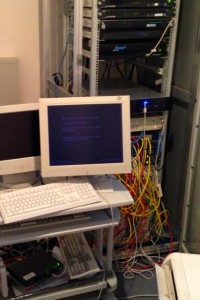Ok, so 3 VMWare ESXi Servers running 20-30 Virtual Machines only slightly qualifies as a “Server Farm”, but we will be saving a ton of electricity (sorry Stadtwerke München ) at SiteForce.
- 3 Mac Mini Server 2,0 GHz Quad Core with 16 GB each running VMWare ESXi 5.0 which peak at just over 60 Watt each (max 180 Watt) – all the old servers, including mail have been moved to virtual machines, except the Open Directory which is on a QNAP NAS Server
- 2 QNAP NAS Servers (with iSCSI for VMWare) at about 45 Watt each (second one is used for redundancy and backups)
- Telephone System will be virtualized with Sipgate
- 2 low-power, fanless Cisco Switches ( < 40 Watt each)
- new Firewall Appliance (< 50 Watt)
- 1 KVM
- 1 older Mac Mini as a Backup Server
- NO MORE air conditioning
- 2 x VMWare ESXi Servers which are Dual Quad Core XEON (2,2 GHz) with 24 GB RAM, and dual power supplies which peak at 650 Watt each (that is 4 power supplies x 650 Watt!!!)
- Mac Pro Dual G5 – with Open Directory and our Mail Server (now on a virtual machine) – with (I am guessing) 450+ Watt
- Firewall – old PC with 400 Watt
- 2 x Quantum Snap Server ( 2 x 400+ Watt)
- QNAP NAS (50 Watt)
- Air Conditioner (300-500 Watt)
- 2 x 5+ year old rack mount switches (200 Watt ?)
- 2 x old PC’s as Servers (2 x 300 Watt?)
- Siemens HiCom Telephone System ( 200 Watt?)
Of course we needed that air conditioning to keep the temp down in the room with all that equipment, and I am sure that some of it is energy efficient and did not always draw full power, but it is safe to say that we had anywhere from 3000-6000 Watt when you add the KVM and Monitor in the rack!
Aside from a few annoying hums from the QNAP NAS Servers, it could almost sit on the desk next to me. Now we are talking something along the lines of 300-475 Watt!!!
That is a HUGE difference. I realize that this is not a very scientific or accurate calculation, but the savings are obvious.
We have a little less CPU Power, but we were already overpowered for our necessary virtual machines, and if we need more CPU for a project now, we just go cloud.
If you want to know more about our MacMini Server VMWare ESXi setup with iSCSI then stay tuned, I’ll write that up one of these days, too.
If you made it this far, you may as well follow me on LinkedIn: Follow Brian Porter

